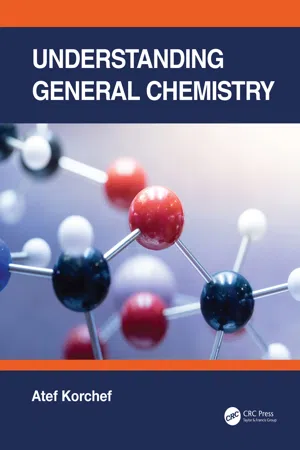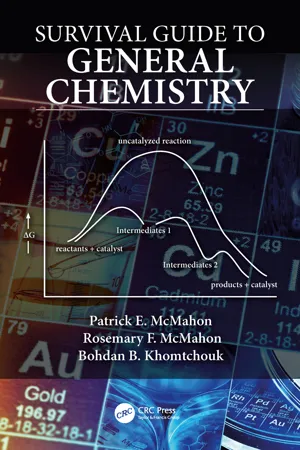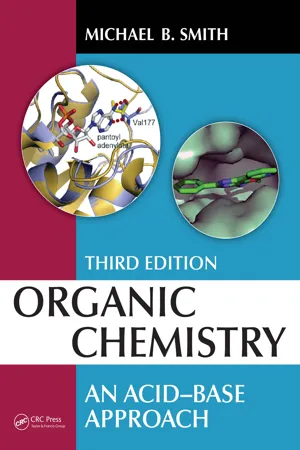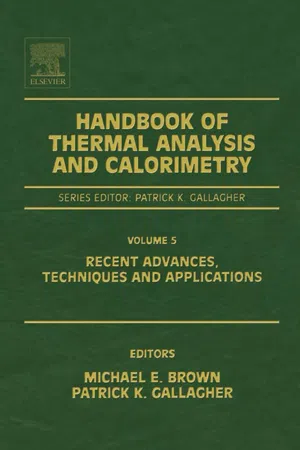Chemistry
Bond Enthalpy
Bond enthalpy is the energy required to break a chemical bond. It is a measure of the strength of a bond and is typically expressed in kilojoules per mole (kJ/mol). When a bond is broken, energy is absorbed, and when a bond is formed, energy is released. Bond enthalpy values are useful for predicting the energy changes in chemical reactions.
Written by Perlego with AI-assistance
Related key terms
Related key terms
1 of 4
Related key terms
1 of 3
5 Key excerpts on "Bond Enthalpy"
- eBook - ePub
- Atef Korchef(Author)
- 2022(Publication Date)
- CRC Press(Publisher)
It is also a measure of the bond strength. Bond Enthalpy values are always positive since bond breaking is an endothermic process. Example: The Bond Enthalpy of the H–H bond, ΔH(H–H), is equal to 436 kJ mol −1, which means that we need an energy of 436 kJ to break the H–H bonds in one mole of H–H bonds. A chemical reaction can be described as the breaking of bonds in the reactants and the making of bonds in the products. Thus, we can calculate the standard enthalpy of the reaction, Δ H rxn ° : Δ H r x n ° = ∑ Δ H b r o k e n b o n d s − ∑ Δ H f o r m e d b o n d s Example: For the ethene hydrogenation. reaction: C 2 H 4 g + H 2 g → C 2 H 6 g, Δ H rxn ° = ? Δ H rxn ° = Δ H C=C + 4 × Δ H C − H + Δ H H − H − Δ H C − C + 6 × Δ H C − H Lattice energy can be defined in two opposite ways: It is the amount of energy that is spent to separate an ionic crystal into its constituent gaseous ions. It is the energy released when gaseous ions bind to form an ionic compound. This process is exothermic, and the values for lattice energy, expressed in kJ mol −1, are negative. The lattice energy can be calculated by applying Hess’s law on a series of individual reactions, forming a cycle. This cycle is called the Born–Haber cycle. The Born–Haber cycle is used to calculate the lattice enthalpy of an ionic compound, formed by a metal and a non-metal. It can be obtained by the following steps: Sublimation of the metal Dissociation of the gaseous non-metal Ionization of the gaseous metal Formation of the gaseous non-metal anion Formation of the ionic compound Example: The Born–Haber cycle for NaCl Δ H 1 ° = Δ H sub Na + 1 2 × Δ H diss Cl 2 + I Na + A e Cl + Δ H Lattice Δ H Lattice = Δ H 1 ° − Δ H sub Na + 1 2 Δ H diss Cl 2 + I Na + A e Cl = − 788 kJ - eBook - ePub
- Patrick E. McMahon, Rosemary McMahon, Bohdan Khomtchouk(Authors)
- 2019(Publication Date)
- CRC Press(Publisher)
Chapter 19 ), a useful working definition of enthalpy can be applied: change in enthalpy (ΔH) can be thought of as the change in the potential energy (ΔPE) of a chemical process as measured by heat transfer to the surroundings. In a limited sense, the “surroundings” essentially represent the matter that contains the chemical process: the solvent in a solution of reactants, the container holding the reactants, and potentially other factors.Enthalpy, as a measure of potential energy change, has equivalent meaning for signs: (−ΔPE of reaction) equates to (−ΔH of reaction). In this case, the potential energy decreases, and energy is released to the surroundings; the reaction is termed exothermic (“heat out”).(+ΔPE of reaction) equates to (+ΔH of reaction). In this case, the potential energy increases, and energy is required to be added from the surroundings; the reaction is termed endothermic (“heat in”).Stronger bonds equate to lower PE; molecules with stronger total bonds are more stable and are lower in potential energy than molecules with weaker total bonds. The BDE of a bond is always a positive value; it is equal in value but opposite in sign to the bonding potential energy PE Stronger bonds will have higher values for BDE; weaker bonds will have smaller values for BDE.Molecules with:For calculation purposes, measurement of bond energies is usually expressed in terms of the bond dissociation energy, BDE. For calculations, the following equation, applying an enthalpy measurement for potential energy can be used.ΔH (reaction) = [total bond BDE (reactants)] − [total bond BDE (products)]A conventional chemical reaction describes the process of converting a specific set of reactants to a specific set of products. The corresponding balanced equation, read from left-to-right, describes what is termed the forward - eBook - ePub
Organic Chemistry
An Acid-Base Approach
- Michael B. Smith(Author)
- 2022(Publication Date)
- CRC Press(Publisher)
ionic compound NaI) reacts with chloromethane to give the chloride ion and iodomethane as products. The solvent is the ether THF (tetrahydrofuran, Sections 5.5.2 and 6.7.3), shown under the reaction arrow.It does not participate in the bond-making and bond-breaking process. The iodide ion reacts as a nucleophile with carbon of the C—Cl unit, which is broken. Chloromethane, the starting material , is always drawn on the left side of the equation. A new C—I bond is formed in iodomethane, the product , which is always drawn on the right side of the equation. The bond strength for the C—Cl bond in chloromethane is 84 kcal (351.5 kJ) mol-1 and the bond strength of C—I in iodomethane is 56 kcal (234.3 kJ) mol-1 , as shown in Table 7.1 .1 The change in energy from reactant to product is the difference in the two values of H° or ΔH° (change in energy), and ΔH° is H°(bonds broken) - H°(bonds made) . For the reaction shown, ΔH° is1 Haynes, W.M. CRC Handbook of Chemistry, 94th ed., CRC Press, Inc., Boca Raton, FL, 2013–2014, pp. 9–71 to 9–79.Table 7.1 Selected Bond Dissociation Energy Values for Bonds In Specific MoleculesΔ H =H−bonds brokenHand Δ H =bonds madeH−Cl − CHC − IΔ H = 84 kcal351.5 kJ− 56 kcalmol− 1234.3 kJ= 28 kcalmol− 1117.2mol− 1The free energy (ΔG°) is the important parameter. If the ΔS° is very small and assumed to be zero, it is clear the calculated value of ΔH° is close to the value of ΔG°, measured in kilocalories. The difference is usually only a few calories. The positive sign for ΔG° (from ΔH°) for this substitution reaction means that this is an endothermic reaction (endergonic) - eBook - ePub
- Detlev Möller(Author)
- 2015(Publication Date)
- De Gruyter(Publisher)
Figure 3.3 ). The electron cannot be particulate described in space and time – it is a probability function of energy density, characterised by socalled quantum numbers. For the purpose of this book, to apply chemistry to environmental processes, it is not necessary to go into details of the atomic structure.Fig. 3.2. Schema of potential energy between two atoms (chemical bond).Chemical bonding occurs when one or more electrons are simultaneously attracted to two nuclei. This is the most important fact about chemical bonding that you should know.In its most fundamental sense, the structure of a molecule is specified by the identity of its constituent atoms and the sequence in which they are joined together, that is, by the bonding connectivity . This, in turn, defines the bonding geometry – the spatial relationship between the bonded atoms (Figure 3.2 ). The energy of a system of two atoms depends on the distance between them. At large distances, the energy is zero, meaning ‘no interaction’. At distances of several atomic diameters attractive forces dominate, whereas at very close approaches the force is repulsive, causing the energy to rise. The attractive and repulsive effects are balanced at the minimum point in the curve (Figure 3.2 ). The internuclear distance at which the potential energy minimum occurs defines the bond length . This is more correctly known as the equilibrium bond length , because thermal motion causes the two atoms to vibrate about this distance. In general, the stronger the bond, the smaller the bond length will be. The bond energy is the amount of work that must be done to pull two atoms completely apart; in other words, it is the same as the depth of the ‘well’ in the potential energy curve shown in Figure 3.2 . This is almost, but not quite the same as the bond dissociation energy actually required to break the chemical bond (we will meet it later with the photodissociation); the difference is the very small zero point energy. - eBook - ePub
Handbook of Thermal Analysis and Calorimetry
Recent Advances, Techniques and Applications
- (Author)
- 2011(Publication Date)
- Elsevier Science(Publisher)
The adiabatic ionization energy and the adiabatic electron affinity of a molecule AB are the minimum energies required to remove or attach an electron from the isolated molecule at zero Kelvin (reactions (14) and (15)) respectively. That means that the transition is between the ground states of all molecules present, assumed to be perfect gases with no interaction among them.(14)(15)The appearance energy of a cation A+ can be defined as the standard enthalpy of reaction (16), where a molecule AB in the gas phase at T = 0 K is ionized and excited to a state by means of an electron or a photon, followed by decomposition into the fragments A+ and B, provided that A+ and B are in their ground states and all the species, including the electron, have zero translational energies.(16)The bond dissociation enthalpy (BDH or DH 298.15 (A-B)) for a species A-B is the enthalpy required for homolytic bond cleavage at T = 298.15 K, reaction (17), and depends exclusively on the relative enthalpies of formation of the reactant and product states.(17)The bond dissociation energy (BDE or D 0 (A-B)) is the energy required for the same reaction at T = 0 K and can be related to the depth of the potential well (D e (A-B)) by the zero point energy (ZPE), equation (18) [105 ]:(18)The bond dissociation enthalpy is a valuable quantity for deriving enthalpies of formation of organic radicals, provided that all the enthalpies of formation of the neutral species present in the homolytic cleavage reaction are known.For ionic and radical species, using all of the previous reactions following a thermochemical cycle, see Figure 3 , various quantities can be derived if the rest of the energetic data present in the cycle are known [3 ,4 ].Figure 3 Relationship between heterolysis, homolysis and electron transfer processes.All of the techniques cited in the preceding sections may be used to study stable long-life species, mainly neutral molecules. Thermochemical data for short-lived and unstable molecules, ions and radicals are measured by other means. Some standard analytical techniques, such as NMR, gas chromatography or mass spectrometry, have been used to derive quantitative thermochemical data [110 ]. Reliable enthalpies of formation of radicals and anions can be derived from ionization potentials, ion intensities and ionic-appearance energies obtained by mass spectrometry [111 ]. The main techniques used, based on measurements of ion intensities are: electron photodetachment spectroscopy [112 ], flowing afterglow [113 ], guided ion-beam mass spectrometry [114 ], high-pressure mass spectrometry [115 ], ion cyclotron resonance mass spectrometry [116 ], kinetic energy release distributions [117 ], Knudsen cell-mass spectrometry [118 ], a mass spectrometry-kinetic method [119 ], photoionization mass spectrometry [120 ] and pulsed high-pressure mass spectrometry [121
Index pages curate the most relevant extracts from our library of academic textbooks. They’ve been created using an in-house natural language model (NLM), each adding context and meaning to key research topics.
Explore more topic indexes
Explore more topic indexes
1 of 6
Explore more topic indexes
1 of 4




